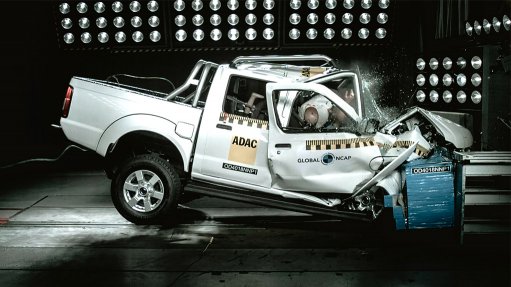
The Nissan NP300 during the NCAP crash test
The Global New Car Assessment Programme (NCAP) and the Automobile Association (AA) of South Africa’s second set of SaferCarsForAfrica crash tests, for four models sold in South Africa, was released on Friday, and revealed varying safety concerns and performance parameters for local customers.
The tests were supported by the FIA Foundation and Bloomberg Philanthropies and were undertaken at an international test facility in Germany.
This followed last year’s tests, the first time the NCAP worked with South Africa, when tests were undertaken on budget cars available in the local market. The tests are international standard frontal offset collision tests, at 64 km/h.
The four models tested this year were the Nissan NP300, the Hyundai i20, the Kia Picanto and the Toyota Yaris.
Entry-level vehicles for each model were selected, thereby ensuring all contained a minimum of one airbag.
For this year’s tests, the models scored across the spectrum on safety performance from zero to three stars for adult protection.
The Nissan NP300 ‘Hardbody’ scored the lowest ratings, which shows a high probability of life threatening injury in a crash.
The body shell of the car collapsed during the test and was rated as unstable, at odds with its ‘Hardbody’ name.
The vehicle produced the lowest score of tests completed to date, with a zero-star rating for its poor adult occupant protection, mainly the driver head and chest area, and only two stars for child occupant protection.
The latter is mainly as a result of the manufacturer installing one of the child seats without following the instructions properly.
The vehicle, despite being the most expensive from the pool, scored the lowest, which indicated that safety does not have to be predicated on price.
Zero-rated vehicles are discouraged by NCAP from even being on the road.
The Toyota Yaris achieved a three-star rating for adult occupant protection, and the structure was rated unstable.
The car provided seatbelt reminders for both frontal positions, and included seatbelts with pretensioners for both front passengers.
Using child seats Toyota-recommended for this model, a three-star rating was achieved for child occupant protection.
The car offers a standard Isofix anchorage for child restraint systems (CRS).
The Hyundai i20 also achieved a three-star rating for adult occupant protection, and the vehicle structure and footwell area were rated unstable.
The car provided seatbelt pretensioners for both front passengers and seatbelt reminders for the driver.
Hyundai-recommended child seats resulted in a two-star rating for child occupant protection, owing to the lack of Isofix anchorages.
Further, unlike its European counterpart, this South African model does not offer electronic stability control, side body airbags and side curtain airbags.
The Kia Picanto too achieved a three-star rating for adult occupant protection. The vehicle structure was rated stable and the footwell area rated unstable.
The car offers seatbelt pretensioners for both front passengers and seatbelt reminders for the driver.
Kia-recommended car seats achieved two-star rating for child protection, owing to the detachment of the Isofix anchorages during the crash test.
Notably, the car seat manufacturer removed Kia from its recommended list of cars for this seat model following this; while the car manufacturer is currently undertaking investigations.
Road safety is of great concern to South Africa, which has an infamously high death rate from road accidents.
AA CEO Collins Khumalo shared chilling statistics from last year, with the fatality rate for South Africa’s December holiday period equal to that of other countries for an entire year.